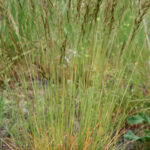Fétuque rouge de Chewings
Festuca rubra
General Description
Chewing’s red fescue is a long-lived, loosely tufted perennial that usually grows from rhizomes and appears in many forms and variants. Both introduced and native types have been recognized as separate species. Over 100 varieties of this complex are sold in Europe. Some have been introduced to North America and have hybridized with native forms.
Type
Tame grass.
Origin
Most cultivars are likely to be of European origin, but some may have been bred from germplasm from Europe and North America.
Longevity
Long-lived.
Use
Reclamation, pasture.
Optimal Time of Use
Awned wheatgrass is optimally grazed prior to seed head development.
Recovery After Use
Graze awned wheatgrass once per year. At least four inches (100mm) of stubble should be left after grazing to maintain vigor.
Palatability/Nutritional Value
Awned wheatgrass is palatable until heading. Awn development and coarse stems at maturity reduce palatability. Digestibility ranges from 55% in June to 35% in October and crude protein ranges from 14% in June to 4% in October.
Annual Precipitation min/max (mm)
350mm / 600mm or higher.
Drought Tolerance
Moderate drought tolerance.
Flooding Tolerance
Withstands approximately one to two weeks of spring flooding.
Winter Hardiness
Good winter hardiness.
Soil Texture Preference
Awned wheatgrass is best suited to moist, well drained loamy textured soils in sheltered areas. Awned wheatgrass is found native in moist shady areas such as coulees, on the edges of brush or tree bluffs, or in wet areas around treed sloughs.
Erosion Control
Not noted for erosion control, but is a useful component of reclamation mixes.
Salinity Tolerance
Slight salinity tolerance.
Acidity Tolerance
Slight acidity tolerance.
Alkalinity Tolerance
Low tolerance.
Seeds per kg
271,000 seeds/kg (123,000 seeds/lb)
Suggested Mixtures
Native seed mixtures for higher moisture areas or sheltered areas. Found in reclamation mixes.
Ease of Establishment
Awned wheatgrass is relatively easy to establish.
Competitiveness
Little is known about its competitiveness in pure stands or simple mixes.
Management Considerations
Allowing seed set and drop every few years will foster stand longevity as little is known about the plant’s lifespan. Although awned wheatgrass is a subspecies of slender wheatgrass, little is known about managing it agronomically.
Saskatchewan Dryland Forage Species Adaptation Tool, USDA Plants Database, British Columbia Rangeland Seeding Manual, Alberta Forage Manual
Chewings fescue is adapted to all zones in the Central Interior except the Bunchgrass zone in the southern part of the region.
Chewings fescue is adapted to the Ponderosa Pine, Interior Douglas-fir and the Interior Cedar-Hemlock zones and mostly limited to reclamation use.
Chewings fescue is grown for seed production in the Peace-Liard region and is used in reclamation applications.
